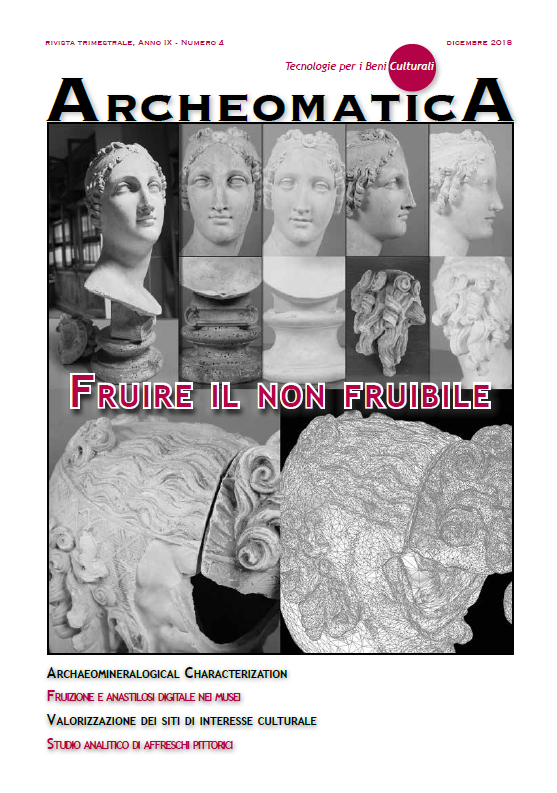Archaeo-mineralogical Characterization of ancient copper and Turquoise mining in south Sinai, Egypt
DOI:
https://doi.org/10.48258/arc.v9i4.1617Parole chiave:
South Sinai, copper ore, turquoise, slag, analysis, stereo microscope, XRF, XRDAbstract
Egyptians probably drew their first supplies of copper as native metal and
step by step from the abundant malachite stones found in south Sinai region
and in the hills near Red Sea in the eastern desert.
There was integrated between the mines of copper and the mines of turquoise
in the literature studies of south Sinai, especially in wadi El-Maghara, Wadi
El-Nasib, Wadi Kharag and serabit El-Khadim, so this study tries to clear this
point and determine exactly the mines of copper and the mines of turquoise.
The study aims to investigate the source zones for copper in south Sinai,
Egypt during the pharaonic ages, to determine the extent of a manufacturing
centre and its position and to know the systems of metallurgical works, fire
places, furnaces, etc.
To achieve that the study had two main aspects: first, a serious survey to
investigate of the mines of south Sinai was a cured; several different mining
features were randomly chosen for excavation such as open cisterns, plates
and galleries, collected every small things and fine details of the mining
technology used at these sites.
Secondly: Careful investigations by a serial of different analytical techniques
for Ore and slag samples from the selected mines have been applied; the
obtained information can be married up and exploited to determine exactly
the main activity for each site.
Riferimenti bibliografici
Bachmann, H. G. (1978) The phase composition of slags from Timna site 39, archaeo-metallurgy, IAMS Mongraph no. 1, pp. 21-23.
Beit-Arieh, I. (1987) Canaanites and Egyptians at Serabit El Khadim,
In Rainly, A., Ed., Egypt, Israel, Sinai, Tel Aviv, p. 59.
Charles B. & Dominique V. (1997) The Middle Kingdom Temple
of Hathor at Serabit el-Khadim, in The temple in Ancient Egypt,
New discoveries and recent research (S. Quirke eds.), British
museum, U.K., p. 82-89.
Craddock P. T. (1980) The composition of copper produced at
the ancient smelting camps in the Wadi Timna, Israel,
British museum Occasional paper no. 20, pp.165-175.
Craddock P. T. (1988) The composition of Metal artifacts from
site T200 and from adjacent sites in the Wadi Timna andArabah,
In The Egyptian Mining temple at Timna (B. Rothenberg ed.,)
London, Institute for Archaeo- Metallurgical studies, Institute of
Archaeology, pp. 169-181.
El Shazly S. M. (1959) Recent Investigations of Egyptian Copper
Deposits, Symp., Appl., Geology in the Near East, Ankara 1955,
Unesco, Cairo.
Gardiner A., Peet T. & Cerny J. (1955) The Inscriptions of Sinai,
Vol. 2, London, P.39.
Gerald F., Vladimir H. & Antonin P. (1995) Application of Geophysics
in the research of ancient mining in Egypt, In Proceedings of the first international conference on Ancient Egyptian Mining &Metallurgy and Conservation of Metallic Artifacts, 10-12 April, Cairo, Egypt, p. 35.
John F. M. (1990) Experimental reconstruction of bronze age
copper smelting based on archaeological evidence From Timna, In The ancient metallurgy of copper (B. Rothenberg ed.), IAMS, London, pp. 78-122.
John F. M. (1995) Simulation experiments on Egyptian new kingdom
copper smelting, In Proceedings of the first international
conference on Ancient Egyptian Mining& Metallurgy and Conservation
of Metallic Artifacts, Cairo, Egypt, 10-12 April, pp.79-87.
Konrad J. A. (1999) Copper, its trade, Manufacture, Use and
Environmental Status, International Copper Association, LTD, USA, p.1.
Lupu A. & Rothenberg B. (1970) The extractive Metallurgy of the
early iron age copper industry, In The Arabh, Israel,
Archaeologia Austriaca, Heft 47, pp.91-130.
Muhly J. (1984) Bibliotheca Orientalis XLI, p. 290.
Nofal A. A. & Waly M. A. (1995) Foundry Technology of Ancient
Egypt, In The 1st Conference on Ancient Egyptian, Cairo, Pp.
– 181.
Paul T. N., & Ian S. (2000) Ancient Egyptian Materials and
technology, Cambridge University Press, p. 152.
Petrie W. M. F. (1906) Researches in Sinai, London.
Rothenberg B. (1970) An Archaeological Survey of South Sinai,
first season, P.E.Q.102, p. 4-29.
Rothenberg B. (1972), Sinai Explorations 1967-1972, Yearbk.
Mus., Haaretz, Tel Aviv, p. 31-42.
Rothenberg B (1983) Exploration and Archaeo-metallurgy, In The
Arabah valley, Bulletin of the Metals museum, Vol. 8, pp.1-16.
Rothenberg B. (1985) Copper smelting furnaces, In Arabah, Israel:
The Archaeological Evidence, British Museum Occasional paper
no. 48, pp.123-150.
Rothenberg B. (1987) Pharaonic copper Mines in south Sinai,
IAMS, London, no. 10/11, pp.1-7.
Rothenberg B., (1990) Copper smelting furnaces, tuyeres, slags,
iongot- mouds and ingots, In The ancient Metallurgy of copper
(B. Rothenberg ed.,) London: IAMS, pp.1-72.
Rothenberg B. (1995) Archaeo-metallurgical survey methodology,
In Proceedings of the 1st international conference on ancient
Egyptian Mining, Metallurgy and Conservation of Metallic
Artifacts, Cairo, Egypt, 10-12 April, pp. 59-77.
Saad El-Din M., Makhtar G. (1998) Sinai, The Site & The History,
New York University Press, p. 40.
##submission.downloads##
Pubblicato
Come citare
Fascicolo
Sezione
Licenza
Gli autori che pubblicano su questa rivista accettano le seguenti condizioni:- Gli autori mantengono i diritti sulla loro opera e cedono alla rivista il diritto di prima pubblicazione dell'opera, contemporaneamente licenziata sotto una Licenza Creative Commons - Attribuzione che permette ad altri di condividere l'opera indicando la paternità intellettuale e la prima pubblicazione su questa rivista.
- Gli autori possono aderire ad altri accordi di licenza non esclusiva per la distribuzione della versione dell'opera pubblicata (es. depositarla in un archivio istituzionale o pubblicarla in una monografia), a patto di indicare che la prima pubblicazione è avvenuta su questa rivista.
- Gli autori possono diffondere la loro opera online (es. in repository istituzionali o nel loro sito web) prima e durante il processo di submission, poiché può portare a scambi produttivi e aumentare le citazioni dell'opera pubblicata (Vedi The Effect of Open Access).





